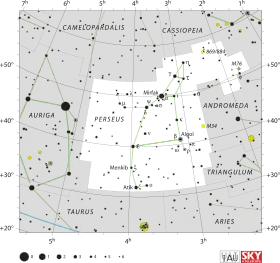Omega Persei
Omega Persei (ω Persei) is a solitary,[6] orange-hued star in the northern constellation of Perseus. It has the traditional name Gorgonea Quarta /ɡɔːrɡəˈniːə ˈkwɔːrtə/,[7] being the fourth member of the quartet called the Gorgonea in reference to the Gorgons from the legend of Perseus. The star is faintly visible to the naked eye with an apparent visual magnitude of +4.6.[2] Based upon an annual parallax shift of 11.32 mas as seen from the Earth,[1] the star is about 288 light years from the Sun.
 | |
| Observation data Epoch J2000.0 Equinox J2000.0 (ICRS) | |
|---|---|
| Constellation | Perseus |
| Right ascension | 03h 11m 17.38161s[1] |
| Declination | +39° 36′ 41.7014″[1] |
| Apparent magnitude (V) | +4.614[2] |
| Characteristics | |
| Spectral type | K0 III[2] |
| B−V color index | 1.122[2] |
| Astrometry | |
| Radial velocity (Rv) | 6.61[2] km/s |
| Proper motion (μ) | RA: −26.26[1] mas/yr Dec.: +5.40[1] mas/yr |
| Parallax (π) | 11.32 ± 0.23[1] mas |
| Distance | 288 ± 6 ly (88 ± 2 pc) |
| Absolute magnitude (MV) | −0.234[3] |
| Details | |
| Mass | 2.04[2] M☉ |
| Radius | 19[4] R☉ |
| Luminosity | 144.5[2] L☉ |
| Surface gravity (log g) | 2.5[4] cgs |
| Temperature | 4,586±18[2] K |
| Metallicity [Fe/H] | −0.10[3] dex |
| Rotational velocity (v sin i) | 3.3[4] km/s |
| Age | 1.65[2] Gyr |
| Other designations | |
| Database references | |
| SIMBAD | data |
This is an evolved K-type giant star with a stellar classification of K0 III.[2] It is a red clump star that is generating energy via helium fusion at its core.[8] At the estimated age of 1.65 billion years, Omega Persei has double[2] times the mass of the Sun and has expanded to about 19[4] times the Sun's radius. It is radiating 144.5 times the Sun's luminosity from its photosphere at an effective temperature of 4,586 K.[2]
References
- van Leeuwen, F. (2007), "Validation of the new Hipparcos reduction", Astronomy and Astrophysics, 474 (2): 653–664, arXiv:0708.1752, Bibcode:2007A&A...474..653V, doi:10.1051/0004-6361:20078357, S2CID 18759600.
- Luck, R. Earle (September 2015), "Abundances in the Local Region. I. G and K Giants", The Astronomical Journal, 150 (3): 23, arXiv:1507.01466, Bibcode:2015AJ....150...88L, doi:10.1088/0004-6256/150/3/88, S2CID 118505114, 88.
- Soubiran, C.; et al. (2008), "Vertical distribution of Galactic disk stars. IV. AMR and AVR from clump giants", Astronomy and Astrophysics, 480 (1): 91–101, arXiv:0712.1370, Bibcode:2008A&A...480...91S, doi:10.1051/0004-6361:20078788, S2CID 16602121.
- Massarotti, Alessandro; et al. (January 2008), "Rotational and Radial Velocities for a Sample of 761 HIPPARCOS Giants and the Role of Binarity", The Astronomical Journal, 135 (1): 209–231, Bibcode:2008AJ....135..209M, doi:10.1088/0004-6256/135/1/209.
- "ome Per". SIMBAD. Centre de données astronomiques de Strasbourg. Retrieved 2017-06-19.
- Eggleton, P. P.; Tokovinin, A. A. (September 2008), "A catalogue of multiplicity among bright stellar systems", Monthly Notices of the Royal Astronomical Society, 389 (2): 869–879, arXiv:0806.2878, Bibcode:2008MNRAS.389..869E, doi:10.1111/j.1365-2966.2008.13596.x, S2CID 14878976.
- Allen, Richard Hinckley (1899), Star-names and their meanings, G. E. Stechert, p. 334
- Alves, David R. (August 2000), "K-Band Calibration of the Red Clump Luminosity", The Astrophysical Journal, 539 (2): 732–741, arXiv:astro-ph/0003329, Bibcode:2000ApJ...539..732A, doi:10.1086/309278, S2CID 16673121.
